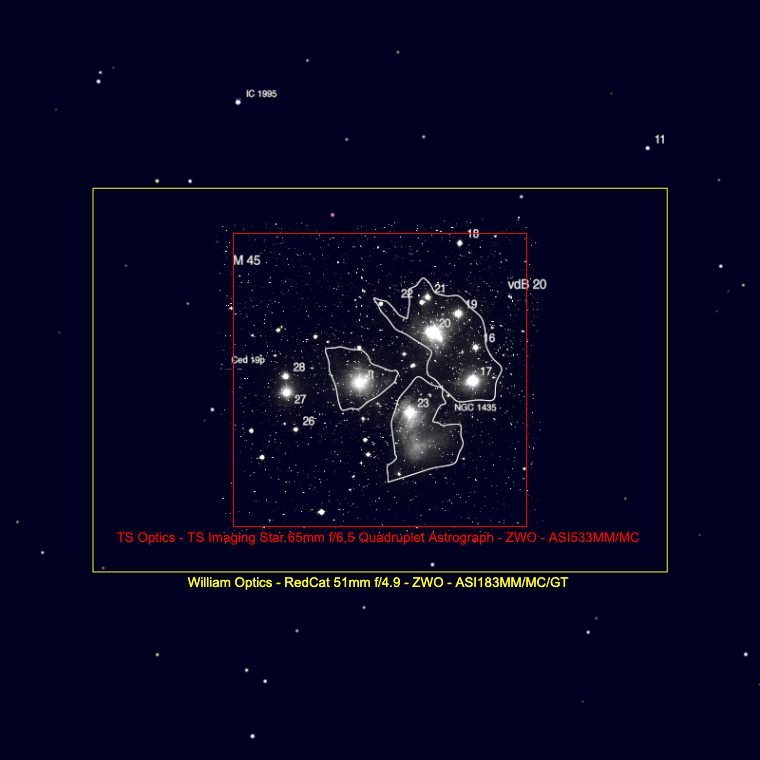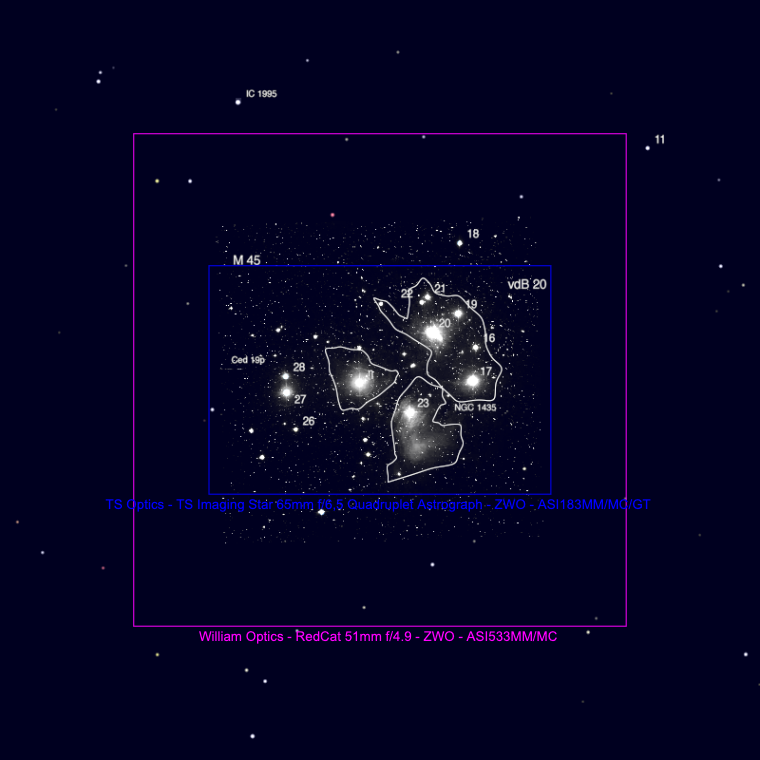I'm currently happy with my Redcat51+Asi 183MMPro and his FOV; I own a Sharpstar 65Q (65/420mm) that I don't use because of FOV with my CMOS.
I dream of building a dual setup to maximize the few nights I can go outside and for this reason I want to ask some advice.
If I buy a ASi 533 OSC+ a 135mm (Askar or Samyang) and use Redcat51+ASI183 for Luminance and Ha is a bad thing?
Or is a better thing but more expensive to buy a ASI 2600 OSC and use it with Sharpstar 65Q and RedCat51+ ASI 183 for luminance and Ha?
|
You cannot like this item. Reason: "ANONYMOUS".
You cannot remove your like from this item.
Editing a post is only allowed within 24 hours after creating it.
You cannot Like this post because the topic is closed.
Copy the URL below to share a direct link to this post.
This post cannot be edited using the classic forums editor.
To edit this post, please enable the "New forums experience" in your settings.
Keep the image scale as close as possible and have the OSC FOV overlapping the FOV of the mono sensor, that is my advice. Use astronomy tools to check the various possible combinations.
|
You cannot like this item. Reason: "ANONYMOUS".
You cannot remove your like from this item.
Editing a post is only allowed within 24 hours after creating it.
You cannot Like this post because the topic is closed.
Copy the URL below to share a direct link to this post.
This post cannot be edited using the classic forums editor.
To edit this post, please enable the "New forums experience" in your settings.
The 135mm aperture will have 7 times the light collection area of the RC51 and 2.5x the resolution. Apature wins in this size range. Adding data from the much smaller aperture won't gain you much. This is the main reason that dual rigs don't make a lot of sense for small OTAs, the efficiency just isn't there. Also, I can't see any profit in polluting the 135 data with the much lower resolution RC51 data.
|
You cannot like this item. Reason: "ANONYMOUS".
You cannot remove your like from this item.
Editing a post is only allowed within 24 hours after creating it.
You cannot Like this post because the topic is closed.
Copy the URL below to share a direct link to this post.
This post cannot be edited using the classic forums editor.
To edit this post, please enable the "New forums experience" in your settings.
Tony Gondola:
The 135mm aperture will have 7 times the light collection area of the RC51 and 2.5x the resolution. Apature wins in this size range. Adding data from the much smaller aperture won't gain you much. This is the main reason that dual rigs don't make a lot of sense for small OTAs, the efficiency just isn't there. Also, I can't see any profit in polluting the 135 data with the much lower resolution RC51 data. He's talking about a Rokinon 135... not a 135mm refractor. The Redcat outperforms the Roki here by a little bit, even though the Roki has a larger aperture.
|
You cannot like this item. Reason: "ANONYMOUS".
You cannot remove your like from this item.
Editing a post is only allowed within 24 hours after creating it.
You cannot Like this post because the topic is closed.
Copy the URL below to share a direct link to this post.
This post cannot be edited using the classic forums editor.
To edit this post, please enable the "New forums experience" in your settings.
Brian Puhl:
Tony Gondola:
The 135mm aperture will have 7 times the light collection area of the RC51 and 2.5x the resolution. Apature wins in this size range. Adding data from the much smaller aperture won't gain you much. This is the main reason that dual rigs don't make a lot of sense for small OTAs, the efficiency just isn't there. Also, I can't see any profit in polluting the 135 data with the much lower resolution RC51 data.
He's talking about a Rokinon 135... not a 135mm refractor. The Redcat outperforms the Roki here by a little bit, even though the Roki has a larger aperture. Ugg!
|
You cannot like this item. Reason: "ANONYMOUS".
You cannot remove your like from this item.
Editing a post is only allowed within 24 hours after creating it.
You cannot Like this post because the topic is closed.
Copy the URL below to share a direct link to this post.
This post cannot be edited using the classic forums editor.
To edit this post, please enable the "New forums experience" in your settings.
Brian Puhl:
The Redcat outperforms the Roki here by a little bit, even though the Roki has a larger aperture. *I very much don't think so if we are talking about efficiency.
|
You cannot like this item. Reason: "ANONYMOUS".
You cannot remove your like from this item.
Editing a post is only allowed within 24 hours after creating it.
You cannot Like this post because the topic is closed.
Copy the URL below to share a direct link to this post.
This post cannot be edited using the classic forums editor.
To edit this post, please enable the "New forums experience" in your settings.
I've played a little with astronomytools. Redcat51+ASI183 resolution 1.98"/pixel Sharpstar 65Q+ ASI 533 1,85"/pixel Which combination would be better for Luminance and which for RGB? As I know better Luminance with higher resolution  |
You cannot like this item. Reason: "ANONYMOUS".
You cannot remove your like from this item.
Editing a post is only allowed within 24 hours after creating it.
You cannot Like this post because the topic is closed.
Copy the URL below to share a direct link to this post.
This post cannot be edited using the classic forums editor.
To edit this post, please enable the "New forums experience" in your settings.
Second option Sharpstar 65Q+ASI 183 resolutionn 1.18"/pixel Redcat51+ASi 533 resolution 3.1"/pixel I think in this solution Sharpstar for Luminance is better and Redcat for RGB  |
You cannot like this item. Reason: "ANONYMOUS".
You cannot remove your like from this item.
Editing a post is only allowed within 24 hours after creating it.
You cannot Like this post because the topic is closed.
Copy the URL below to share a direct link to this post.
This post cannot be edited using the classic forums editor.
To edit this post, please enable the "New forums experience" in your settings.
The optimum combination is the first since they yield similar resolution and you can still feed the RGB into the luminance channel (or Ha/OIII if you use Dual NB) and still capture at the same time the Luminance (or Ha/OIII) signal. So you get the best of both worlds. In the other case the extra time or better SNR would be wasted for RGB because you'll have to spend a lot more time for L.
|
You cannot like this item. Reason: "ANONYMOUS".
You cannot remove your like from this item.
Editing a post is only allowed within 24 hours after creating it.
You cannot Like this post because the topic is closed.
Copy the URL below to share a direct link to this post.
This post cannot be edited using the classic forums editor.
To edit this post, please enable the "New forums experience" in your settings.




